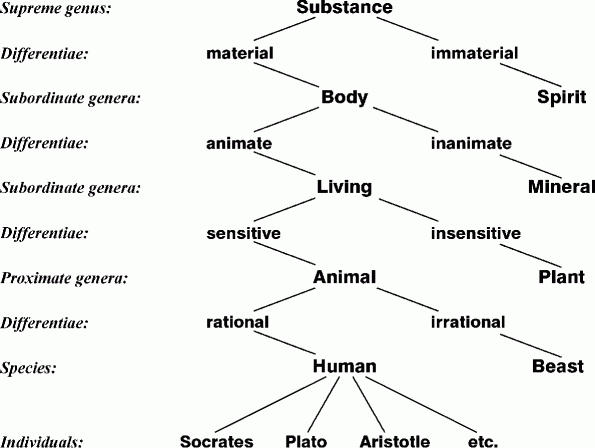Philosophy 433
Philosophy of Aristotle
University of Washington
Definitions and the Tree of Porphyry

The Form of a Definition by genus and differentia
Each definition takes the form:
- Definiendum =df differentia + genus
where the definiendum is a species (or genus), and the definiens is the formula that consists of the differentia + the genus (or super-genus). Thus, just as a species is defined in terms of its genus and a differentia that marks it off from other species of that genus, each genus is defined in terms of its super-genus and a differentia that marks it off from other coordinate genera falling under that super-genus.
Some of the definitions embodied in the tree above
- Body =df material substance
- Living thing =df animate body
- Animal =df sensitive living thing
- Human =df rational animal
Fully explicit definitions
In a fully explicit definition, each definable term (definiendum) is replaced by its definiens. Thus, the fully explicit definition of human will be:
- Human =df rational sensitive animate material substance
This is obtained from the compressed definition above by successively replacing
each definable term (definiendum) in the definition with its definiens. Thus,
we replace ‘animal’ in ‘human =df rational animal’ with its definiens and obtain ‘human =df rational sensitive living thing’. We then do the same for the definiendum‘living thing’ to get ‘human =df rational sensitive animate body’, and finally, replacing ‘body’ with its definiens ‘material substance’ we obtain the fully explicit
definition above. A glance at the Tree of Porphyry shows that the complete definition
of a species consists of its differentia together with the differentiae of all
of the genera under which it falls. In this way, all the genera (except for
the supreme genus) seem to disappear from the definition, and thus, as Aristotle
says (Metaph. Z.12, 1037b30) “there is nothing in the definition except
the first-named genus and the differentiae.”
There will be many differentiae because there is at least one differentia at each level: species, genus, super-genus, super-super-genus, etc.
Return to PHIL 433 Home Page
Copyright © 2007 - S. Marc Cohen
All Rights Reserved